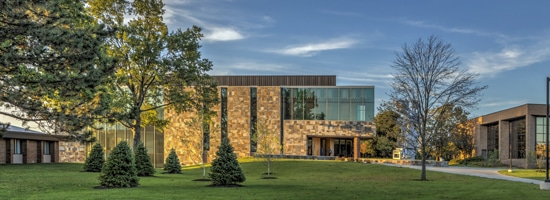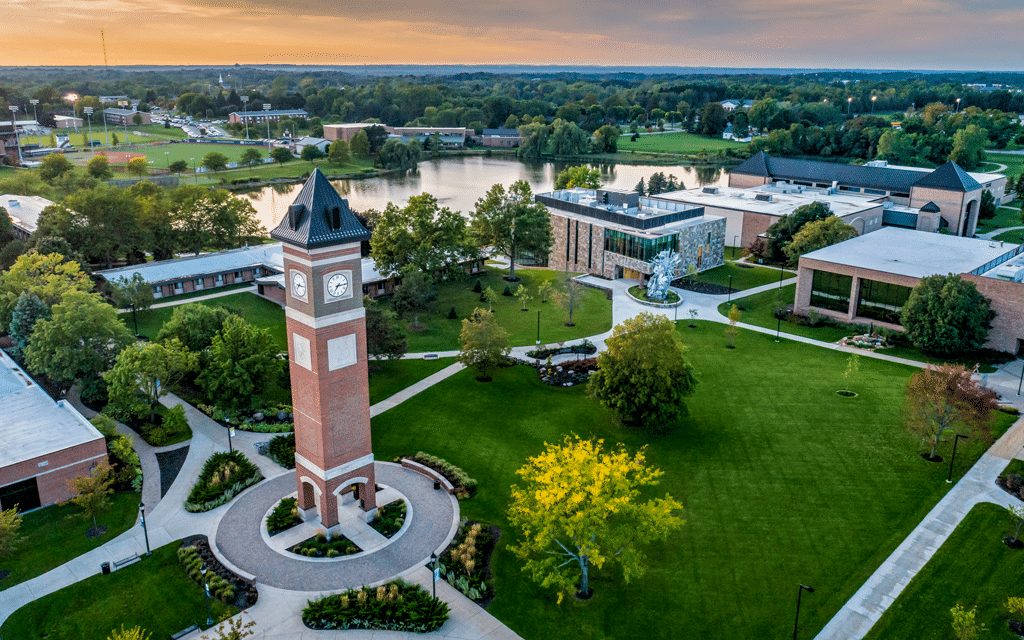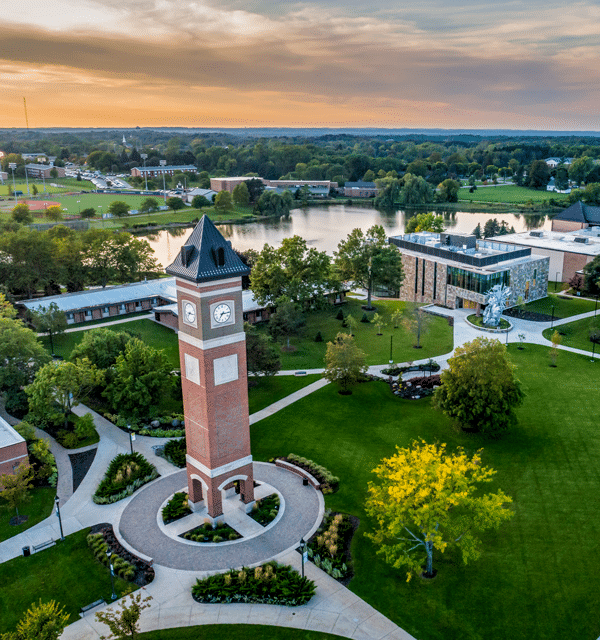University Outcomes
At Cornerstone University and Cornerstone Theological Seminary, we’re committed to helping students succeed, whatever that may look like for them. We take seriously our role to equip students with the knowledge, skills and dispositions they’ll need to thrive both in their present and future vocation.
Student and
Academic Learning Outcomes
In our desire to express the value of a Cornerstone education, CU is committed to publishing data regarding retention rates, graduation rates, placement rates, licensure rates and other relevant information related to student and academic learning outcomes of the university at both the undergraduate and graduate levels.
While reviewing this information, please keep the following in mind:
- All graduation rates are based on up to six years of attendance for bachelor’s programs, which equates to 150% of the normal completion time.
- We have elected not to report transfer-out rates because our College’s mission does not include providing substantial preparation for students to enroll in another eligible institution without completing or graduating.
- These charts do not identify the reasons why our students withdrew; therefore, students who withdrew for personal or medical reasons are included.
- Graduation rates do not include students who left school to serve in the U.S. Armed Forces, on official church missions, or with a foreign aid service of the federal government, or students who died or were totally and permanently disabled.
Jump To:
- Traditional Undergraduate Outcomes
- Professional & Graduate Studies Outcomes
- Cornerstone Theological Seminary Outcomes
- Asia Biblical Theological Seminary Outcomes
- University Resources
- Student-Athlete Outcomes
Traditional Undergraduate Outcomes
Retention and Graduation Rates
| Cohort Year | Freshman Retention Rate* | Four-Year Graduation Rate | Six-Year Graduation Rate |
|---|---|---|---|
| 2011 | 76% | 36.6% | 52.1% |
| 2012 | 74.24% | 43.9% | 55.8% |
| 2013 | 75.65% | 49.6% | 60.29% |
| 2014 | 76.49% | 53% | 64.9% |
| 2015 | 75.16% | 51.86% | 58.70% |
| 2016 | 73.5% | 49.82% | 58.85% |
| 2017 | 79.57% | 54.84% | |
| 2018 | 78.52% | 55.87% | |
| 2019 | 83.85% | ||
| 2020 | 78.70% | ||
| 2021 | 79% |
*One-year retention rates reflect first-time, full-time, degree-seeking freshmen who returned their second year. Six-year graduation rates reflect full-time, degree-seeking students who graduated within six years.
[New Style]
RETENTION RATES
Institutions must make available to current and prospective students the retention rate of certificate- or degree- seeking, first-time, undergraduate students as reported to IPEDS. This information is collected in the IPEDS Fall Enrollment Survey.*
Retention from Fall 2022 to Fall 2023:
- Full-time … 50% (50 / 100)
- Part-time … 50% (50 / 100)
GRADUATION RATES
Each institution must annually make available to prospective and enrolled students the completion or graduation rate of certificate- or degree-seeking, first-time, full-time, undergraduate students. The completion or graduation rates must be disaggregated by
- gender;
- major racial and ethnic subgroup (as defined in IPEDS);
- recipients of a Federal Pell Grant;
- recipients of a subsidized Stafford Loan who did not receive a Pell Grant; and
- students who did not receive either a Pell Grant or a subsidized Stafford Loan.
These disaggregated rates are to be disclosed only If the number of students in each group is sufficient to yield statistically reliable information and not reveal personally identifiable information about an individual student.**
Percent of 2017 cohort who earned bachelor’s degree from SampleSchool by Aug 31 2023:
- Overall … 50% (50 / 100)
- Men … 50% (50 / 100)
- Women … 50% (50 / 100)
- U.S. Nonresident … 50% (50 / 100)
- Hispanic / Latino … 50% (50 / 100)
- American Indian or Alaskan Native … (Number of Students Below 10)
- Asian … 50% (50 / 100)
- Black or African American … 50% (50 / 100)
- White … 50% (50 / 100)
- Two or More Races … 50% (50 / 100)
- Recipients of a Pell Grant … 50% (50 / 100)
- Recipient of a subsidized Stafford Loan (but no Pell Grant) … 50% (50 / 100)
- Neither Pell Grant nor Stafford Loan … 50% (50 / 100)
(Rates are disclosed if the number of students is at least 10. Please note that rates based on small numbers of students — e.g. fewer than 50 — are statistically unreliable.)
* HEOA Sec. 488(a)(1)(E) amended HEA Sec. 485(a)(1) (20 U.S.C. 1092(a)(1)): added HEA Sec. 485(a)(1)(U): HEOA amendment effective August 14, 2008 October 29, 2009 FR notice (revised 34 CFR 668.41(d))
Data reported in IPEDS 2020-21 Fall Enrollment Survey, Spring, 2024.
** HEOA Sec. 488(a)(2) amended HEA Sec. 485(a) (20 U.S.C. 1092(a)): new HEA Sec. 485(a)(4) HEOA Sec. 488(a)(3) amended HEA Sec. 485(a) (20 U.S.C. 1092(a)): added HEA Sec. 485(a)(7) HEOA amendments effective August 14, 2008 34 CFR 668.41(a)-(d), 34 CFR 668.45, 34 CFR 668.8(b)(1)(ii) October 29, 2009 FR notice (revised 34 CFR 668.45)
Data reported in IPEDS 2020-21 Graduation Rate Survey, Spring, 2024.
Persistence Rates
| Year | Fall to Spring Rate** | Spring to Fall Rate** |
|---|---|---|
| 2015-16 | 90% | 78% |
| 2016-17 | 91% | 81% |
| 2017-18 | 92% | 80% |
| 2018-19 | 92% | 87% |
| 2019-20 | 93% | 84% |
| 2020-21 | 93% | 90% |
| 2021-22 | 91% | 87% |
**These rates are based on the total number of individuals who returned the following semester divided by the total number of possible returning students (i.e., excludes those who graduated).
Employment and Graduate School Placement Rates
| Graduation Year | Rate*** | Knowledge Rate**** |
|---|---|---|
| 2016 | 94% | 93% |
| 2017 | 94% | 99% |
| 2018 | 94% | 97% |
| 2019 | 96% | 98% |
| 2020 | 95% | 90% |
| 2021 | 94% | 89% |
***This number reflects the percentage of traditional undergraduate graduates who were employed or enrolled in graduate school within six months of graduation.
****The knowledge rate reflects the percentage of graduates for which Cornerstone was able to gather employment or graduate school information.
Licensure/Certification Exam Pass Rates
Academic Learning Outcomes
Cornerstone University equips students to excel as flourishing influencers in the world for Christ and His kingdom. Here, we define vocational preparation as the faithful stewardship of one’s God-given talents and opportunities throughout his or her professional, personal and civic life. As a result, our Christ-centered, student-focused learning community supports the development of intellectual curiosity, character-based virtues and creative habits.
Comprised of multiple principal academic units, Cornerstone awards associate (A.A., A.S.); bachelor’s (B.A., B.Mus., B.S., B.S.W.); master’s (M.A., M.B.A., M.Div., M.S.); and doctoral (Ed.D.) degrees.
Educational Outcomes
Our graduates enter career fields, ministry roles and graduate programs with essential knowledge and skills in five distinct areas or learning domains, all of which help produce well-rounded individuals who are prepared to influence the world for Christ. Our five university-wide learning outcomes include specialized knowledge; applied knowledge and collaborative learning; intellectual skills; civic and global learning and biblical worldview integration.
- Specialized Knowledge: Cornerstone students will demonstrate knowledge of and proficiency in the terminology, theories, concepts, practices and skills specific to their field of study.
- Applied Knowledge and Collaborative Learning: Cornerstone students will exhibit competency in applying their knowledge to address real-life problems through both individual and group effort.
- Intellectual Skills: Cornerstone students will demonstrate their ability to integrate both traditional and non-traditional cognitive skills, including analytical inquiry, information literacy, quantitative fluency and communicative fluency.
- Civic and Global Engagement: Cornerstone students will demonstrate intercultural competence in addressing civic, social, environmental and economic issues.
- Biblical Worldview Integration: Cornerstone students will be able to articulate a Christ-centered worldview and its personal, professional and communal embodiment through Christian virtues.
Program-Specific Learning Outcomes
Professional & Graduate Studies Outcomes
Retention Rates
Cornerstone University’s Professional & Graduate Studies division tracks attendance and students’ successful completion of the first and second classes in each cohort. To calculate data, the Professional & Graduate Studies division looks at whether or not students have persisted in a given cohort. A student is considered retained when they receive a grade for a course or take a leave of absence.
| Degree Level | Academic Year | 1st Course Retention Rate Average | 2nd Course Retention Rate Average |
|---|---|---|---|
| Associate | 2018-19 | 98.27% | 93.61% |
| Associate | 2019-20 | 96.9% | 93.34% |
| Associate | 2020-21 | 96.43% | 90.56% |
| Bachelor’s | 2018-19 | 98.18% | 93.05% |
| Bachelor’s | 2019-20 | 96.98% | 93.72% |
| Bachelor’s | 2020-21 | 97.29% | 91.59% |
| Master’s | 2018-19 | 98.17% | 93.28% |
| Master’s | 2019-20 | 97.06% | 93.56% |
| Master’s | 2020-21 | 97.15% | 90.61% |
Graduation Rates
Cornerstone University’s Professional & Graduate Studies division calculates four-year and six-year graduation rates at end of each academic year for bachelor’s, master’s and doctoral degrees and the six-year graduation rate for associate degrees.
To calculate graduation rates, the Professional & Graduate Studies division looks at all students whose initial start date at a given degree level (i.e., associate, bachelor’s, master’s, doctorate) falls within the date parameters in question. The university then looks at students’ current academic status (i.e., active, withdrawn, graduate). The ratio of graduates to the total number of students gives Cornerstone its graduation rate for the academic year in question.
| Degree Level | Academic Year | Six-Year Graduation Rate |
|---|---|---|
| Associate | 2008/2009 | 36% |
| Associate | 2009/2010 | 47% |
| Associate | 2010/2011 | 43% |
| Associate | 2011/2012 | 39% |
| Associate | 2012/2013 | 33% |
| Associate | 2013/2014 | 37% |
| Associate | 2014/2015 | 38% |
| Associate | 2015/2016 | 41% |
| Bachelor’s | 2008/2009 | 66% |
| Bachelor’s | 2009/2010 | 70% |
| Bachelor’s | 2010/2011 | 68% |
| Bachelor’s | 2011/2012 | 75% |
| Bachelor’s | 2012/2013 | 66% |
| Bachelor’s | 2013/2014 | 73% |
| Bachelor’s | 2014/2015 | 66% |
| Bachelor’s | 2015/2016 | 68% |
| Master’s | 2008/2009 | 75% |
| Master’s | 2009/2010 | 76% |
| Master’s | 2010/2011 | 74% |
| Master’s | 2011/2012 | 76% |
| Master’s | 2012/2013 | 80% |
| Master’s | 2013/2014 | 81% |
| Master’s | 2014/2015 | 73% |
| Master’s | 2015/2016 | 80% |
| Doctorate | 2015/2016 | 46.2% (four-year grad rate) |
Student Outcomes
Professional & Graduates Studies (PGS) works with Cornerstone University’s Alumni Office to survey all students who graduated during a given academic year (i.e., December, May and August grads). The following rates demonstrate the percentage of students who were employed or in grad school within six months of completing their degree programs.
PGS Graduate Survey Employment Rates
| Survey/Sample Size | Associate | Bachelor’s | Master’s | Doctoral | Overall Average |
|---|---|---|---|---|---|
| 2015-16 Graduate Survey 92 total respondents |
83% | 93% | 95% | N/A | 90.33% |
| 2016-17 Graduate Survey 57 total respondents |
98% | 93% | 92% | N/A | 94.33% |
| 2017-18 Graduate Survey 61 total respondents |
94% | 95% | 93% | N/A | 94% |
| 2018-19 Graduate Survey 51 total respondents |
90% | 94% | 93% | N/A | 92.33% |
| 2019-20 Graduate Survey 63 total respondents |
89% | 95% | 93% | N/A | 92.33% |
| 2020-21 Graduate Survey 45 total respondents |
50% | 95% | 100% | N/A | 81.67% |
| 2021-22 Graduate Survey 49 total respondents |
75% | 95% | 95% | 100% | 93.87% |
Academic Learning Outcomes
Cornerstone University equips students to excel as flourishing influencers in the world for Christ and His kingdom. Here, we define vocational preparation as the faithful stewardship of one’s God-given talents and opportunities throughout his or her professional, personal and civic life. As a result, our Christ-centered, student-focused learning community supports the development of intellectual curiosity, character-based virtues and creative habits.
Comprised of multiple principal academic units, Cornerstone awards associate (A.A., A.S.); bachelor’s (B.A., B.Mus., B.S., B.S.W.); master’s (M.A., M.B.A., M.Div., M.S.); and doctoral (Ed.D.) degrees.
Educational Outcomes
Our graduates enter career fields, ministry roles and graduate programs with essential knowledge and skills in five distinct areas or learning domains, all of which help produce well-rounded individuals who are prepared to influence the world for Christ. Our five university-wide learning outcomes include specialized knowledge; applied knowledge and collaborative learning; intellectual skills; civic and global learning and biblical worldview integration.
- Specialized Knowledge: Cornerstone students will demonstrate knowledge of and proficiency in the terminology, theories, concepts, practices and skills specific to their field of study.
- Applied Knowledge and Collaborative Learning: Cornerstone students will exhibit competency in applying their knowledge to address real-life problems through both individual and group effort.
- Intellectual Skills: Cornerstone students will demonstrate their ability to integrate both traditional and non-traditional cognitive skills, including analytical inquiry, information literacy, quantitative fluency and communicative fluency.
- Civic and Global Engagement: Cornerstone students will demonstrate intercultural competence in addressing civic, social, environmental and economic issues.
- Biblical Worldview Integration: Cornerstone students will be able to articulate a Christ-centered worldview and its personal, professional and communal embodiment through Christian virtues.
Program-Specific Learning Outcomes
Cornerstone Theological Seminary Outcomes
Educational Effectiveness and Student Outcomes
Assessment of student learning is highly valued at Cornerstone Theological Seminary. It is our responsibility to deliver on the promise to provide excellence in graduate theological education. At CTS, assessment of student outcomes is not an externally imposed burden. Rather, assessment of student learning and the disclosure of educational effectiveness is a task of stewardship, a process for organizational learning, and a matter of accountability.
The effectiveness of our educational programs is assessed in a disciplined and routine manner. Through a variety of instruments and processes, we assess the achievement of the intended student learning outcomes of our curriculum, student and alumni satisfaction, readiness for ministry of our students, and vocational achievement of our graduates.
The following provides a few highlights and demonstrates how CTS is delivering on its promise to provide excellence in graduate theological education.
Vocational Readiness for Ministry
| Academic Year | Midpoint Assessment | Exit Assessment |
|---|---|---|
| 2015-16 | 94% | 97% |
| 2016-17 | 83% | 100% |
| 2017-18 | 90% | 100% |
| 2018-19 | 78% | 92% |
| 2019-20 | 79% | 96% |
| 2020-21 | 77% | 100% |
| 2021-22 | 100% | 94% |
*Percentage of students completing the assessment process that received an outcome of fully affirm in vocational readiness
Vocational Outcomes
| Academic Year | Master of Divinity Placement Rate |
Master of Divinity Knowledge Rate |
Master of Arts Placement Rate |
Master of Arts Knowledge Rate |
|---|---|---|---|---|
| 2017-18 | 100% | 94% | 97% | 94% |
| 2018-19 | 83% | 92% | 83% | 95% |
| 2019-20 | 93% | 100% | 88% | 93% |
| 2020-21 | 100% | 100% | 97% | 94% |
| 2021-22 | 100% | 100% | 85% | 90% |
*Percentage of students reporting vocational placement or enrollment in continuing education 6-12 months post-graduation.
Retention and Graduation Rates
| Cohort Year | First-Year (FA to FA) Retention Rate |
Master of Arts Graduation Rate (3 Years) |
Master of Divinity Graduation Rate (5 Years) |
|---|---|---|---|
| 2012-13 | 76% | 71% (15-16 Grads) | 42% (17-18 Grads) |
| 2013-14 | 73% | 49% (16-17 Grads) | 58% (18-19 Grads) |
| 2014-15 | 71% | 52% (17-18 Grads) | 57% (19-20 Grads) |
| 2015-16 | 73% | 49% (18-19 Grads) | 52% (20-21 Grads) |
| 2016-17 | 82% | 60% (19-20 Grads) | 82% (21-22 Grads) |
| 2017-18 | 89% | TBD (20-21 Grads) | TBD (22-23 Grads) |
| 2018-19 | 80% | TBD (21-22 Grads) | TBD (23-24 Grads) |
| 2019-20 | 78% | TBD (22-23 Grads) | TBD (24-25 Grads) |
| 2020-21 | 77% | TBD (23-24 Grads) | TBD (25-26 Grads) |
| 2021-22 | 41% | TBD (24-25 Grads) | TBD (26-27 Grads) |
*First-year retention rates reflect percentage of students from the respective cohort returning their second year (FA to FA). Graduation rates reflect the percentage of those in a respective cohort who completed their degree (M.A. or M.Div.) in three or five years respectively.
Licensure Exam Pass Rates
NCE Pass Rates—Clinical Mental Health Counseling
The pass rate for the National Counselor Examination (NCE) as given by the State of Michigan for graduates of Cornerstone University (GRTS) is 100%.
The State of Michigan provides NCE pass rates for any counselor who has a Michigan license (limited or full). The State of Michigan does not track NCE pass rates for those who have never applied for a license.
The National Counselor Examination (NCE) is offered through the National Board of Certified Counselors (NBCC). The NBCC does not track pass rates for those that take the NCE; they only track those who take the exam as part of the National Certified Counselor (NCC) process.
Academic Learning Outcomes
Cornerstone University equips students to excel as flourishing influencers in the world for Christ and His kingdom. Here, we define vocational preparation as the faithful stewardship of one’s God-given talents and opportunities throughout his or her professional, personal and civic life. As a result, our Christ-centered, student-focused learning community supports the development of intellectual curiosity, character-based virtues and creative habits.
Comprised of multiple principal academic units, Cornerstone awards associate (A.A., A.S.); bachelor’s (B.A., B.Mus., B.S., B.S.W.); master’s (M.A., M.B.A., M.Div., M.S.); and doctoral (Ed.D.) degrees.
Educational Outcomes
Our graduates enter career fields, ministry roles and graduate programs with essential knowledge and skills in five distinct areas or learning domains, all of which help produce well-rounded individuals who are prepared to influence the world for Christ. Our five university-wide learning outcomes include specialized knowledge; applied knowledge and collaborative learning; intellectual skills; civic and global learning and biblical worldview integration.
- Specialized Knowledge: Cornerstone students will demonstrate knowledge of and proficiency in the terminology, theories, concepts, practices and skills specific to their field of study.
- Applied Knowledge and Collaborative Learning: Cornerstone students will exhibit competency in applying their knowledge to address real-life problems through both individual and group effort.
- Intellectual Skills: Cornerstone students will demonstrate their ability to integrate both traditional and non-traditional cognitive skills, including analytical inquiry, information literacy, quantitative fluency and communicative fluency.
- Civic and Global Engagement: Cornerstone students will demonstrate intercultural competence in addressing civic, social, environmental and economic issues.
- Biblical Worldview Integration: Cornerstone students will be able to articulate a Christ-centered worldview and its personal, professional and communal embodiment through Christian virtues.
Program-Specific Learning Outcomes
Asia Biblical Theological Seminary Outcomes
Retention and Graduation Rates
| Year Accepted | 1st Year Student Retention Rate* | 5-Year Graduation Rate** | Degree Program Graduation Rate*** |
|---|---|---|---|
| 2015 | 65% | 42% | 58%**** |
| 2016 | 78% | 58% | 62%***** |
| 2017 | 89% | 32% | 50%****** |
| 2018 | 78% | ||
| 2019 | 78% | ||
| 2020 | 72% | ||
| 2021 | 81% |
* Percentage of students who enrolled in a course during the year following their year of acceptance into a degree program
**Percentage of students who graduated within 5 years of acceptance into a degree program
***Cumulative percentage of students who graduated regardless of timeline
****An additional 21% are still active students
*****An additional 17% are still active students
******An additional 25% are still active students
University Resources
Annual Assessment Reports
For Cornerstone, assessment is a matter of institutional integrity. In addition to providing an opportunity for organizational learning and a credible foundation for data-based decision making, we view assessment as an ongoing and cyclical process.
Purpose of Assessment
Because we understand assessment as having internal value and theological connections, Cornerstone engages in the work of assessment to achieve the following objectives:
- To document an explicit plan and process for assessing student learning.
- To clearly articulate a set of student learning outcomes for degree programs and individual courses.
- To map intended student learning outcomes (SLOs) across the curriculum (e.g., mapping SLOs to select courses and student learning artifacts).
- To enact assessment projects on a scheduled and routine basis which seek to measure the level of achievement of the intended student learning outcomes at the course and program level.
- To identify needed changes to the curriculum (programs and courses) through the work of assessment.
- To demonstrate the administrative will to enact the needed changes identified in the work of assessment.
- To document the changes to curriculum resulting from the administration of the assessment plan and process.
- To develop as educational professionals in the art and science of assessment of student learning.
- To facilitate a culture of assessment that leads to continuous improvement of curriculum, personnel, programs and overall educational quality.
Assessment Reports
Our annual assessment reports reflect the work of the university in the area of assessment. The reports highlight some of the best practices observed in specific divisions or courses. In addition, the reports outline next steps we are taking to invest in the advancement of assessment at Cornerstone.
Annual Assessment Report for 2021-22
Annual Assessment Report for 2020-21
Annual Assessment Report for 2019-20
Annual Assessment Report for 2018-19
Annual Assessment Report for 2017-18
Annual Assessment Report for 2016-17
Annual Assessment Report for 2015-16
Annual Assessment Report for 2012-13
Annual Assessment Report for 2010-11
Annual Assessment Report for 2009-10
Annual Assessment Report for 2008-09
Annual Assessment Report for 2007-08
Student-Athlete Outcomes
Table 1: All Students Fall 2015 Cohort
| Category | Graduation/Completion Rate |
|---|---|
| Gender | |
| Men | 62% |
| Women | 59% |
| Race or Ethnicity | |
| Non-Resident Alien | 80% |
| Black or AA | 35% |
| American Indian/Alaskan Native | |
| Asian | |
| Nat Hawaiian or Other Pacific Islander | |
| Hispanic or Latino | 55% |
| White Non-Hispanic | 61% |
| Two or more races | 50% |
| Race/Ethnicity Unknown | n/a |
| Financial Aid | |
| Pell Grant Recipient | 60% |
| FFEL or Direct Loan Recipient – Subsidized | 58% |
| Neither a Federal Pell Grant or FFEL, or a Federal Direct Loan Recipient | 61% |
*Note: Blank denotes any cohort/sub-cohort with fewer than 5 students, which is suppressed to protect the privacy of students.
Table 2: Fall 2015 Cohort
| Category | General Student Body | Basketball | Baseball | Bowling | Cheerleading | Cross-Country | Golf | Soccer | Tennis | Track | Softball | Volleyball |
|---|---|---|---|---|---|---|---|---|---|---|---|---|
| Men | ||||||||||||
| Non-Resident Alien | 88% | 88% | 85% | |||||||||
| Black or AA | 30% | 30% | ||||||||||
| American Indian/Alaskan Native | ||||||||||||
| Asian | ||||||||||||
| Nat Hawaiian or Other Pacific Islander | ||||||||||||
| Hispanic or Latino | 20% | |||||||||||
| White Non-Hispanic | 65% | 65% | 87% | 66% | ||||||||
| Two or more races | 50% | |||||||||||
| Race/Ethnicity Unknown | ||||||||||||
| Total Men | 62% | 62% | 81% | 66% | ||||||||
| Women | ||||||||||||
| Non-Resident Alien | 57% | |||||||||||
| Black or AA | 40% | |||||||||||
| American Indian/Alaskan Native | ||||||||||||
| Asian | 100% | |||||||||||
| Nat Hawaiian or Other Pacific Islander | ||||||||||||
| Hispanic or Latino | 65% | |||||||||||
| White Non-Hispanic | 59% | 90% | 14% | 50% | 55% | 100% | ||||||
| Two or more races | 50% | |||||||||||
| Race/Ethnicity Unknown | ||||||||||||
| Total Women | 58% | 90% | n/a | n/a | 14% | n/a | 50% | 55% | 100% | |||
*Note: Blank denotes any cohort/sub-cohort with fewer than 5 students, which is suppressed to protect the privacy of students.
Table 3: Four Year Average Fall 2012-2015
| Category | General Student Body | Basketball | Baseball | Bowling | Cheerleading | Cross-Country | Golf | Soccer | Tennis | Track | Softball | Volleyball |
|---|---|---|---|---|---|---|---|---|---|---|---|---|
| Men | na | na | ||||||||||
| Non-Resident Alien | 53% | 59% | na | na | ||||||||
| Black or AA | 41% | na | na | |||||||||
| American Indian/Alaskan Native | na | na | ||||||||||
| Asian | 60% | na | na | |||||||||
| Nat Hawaiian or Other Pacific Islander | na | na | ||||||||||
| Hispanic or Latino | 39% | na | na | |||||||||
| White Non-Hispanic | 63% | 75% | 69% | 66% | 71% | 56% | na | na | ||||
| Two or more races | 33% | na | na | |||||||||
| Race/Ethnicity Unknown | na | na | ||||||||||
| Total Men | 60% | 71% | 64% | 66% | 67% | 83% | 58% | na | na | |||
| Women | na | |||||||||||
| Non-Resident Alien | 63% | na | ||||||||||
| Black or AA | 41% | na | ||||||||||
| American Indian/Alaskan Native | 80% | na | ||||||||||
| Asian | 54% | na | ||||||||||
| Nat Hawaiian or Other Pacific Islander | na | |||||||||||
| Hispanic or Latino | 57% | na | ||||||||||
| White Non-Hispanic | 62% | 82% | na | 43% | 14% | 83% | 57% | 43% | 70% | 92% | 84% | |
| Two or more races | 33% | na | ||||||||||
| Race/Ethnicity Unknown | na | |||||||||||
| Total Women | 60% | 83% | na | 40% | 83% | 62% | 58% | 70% | 92% | 86% | ||
*Note: Blank denotes any cohort/sub-cohort with fewer than 5 students, which is suppressed to protect the privacy of students.







